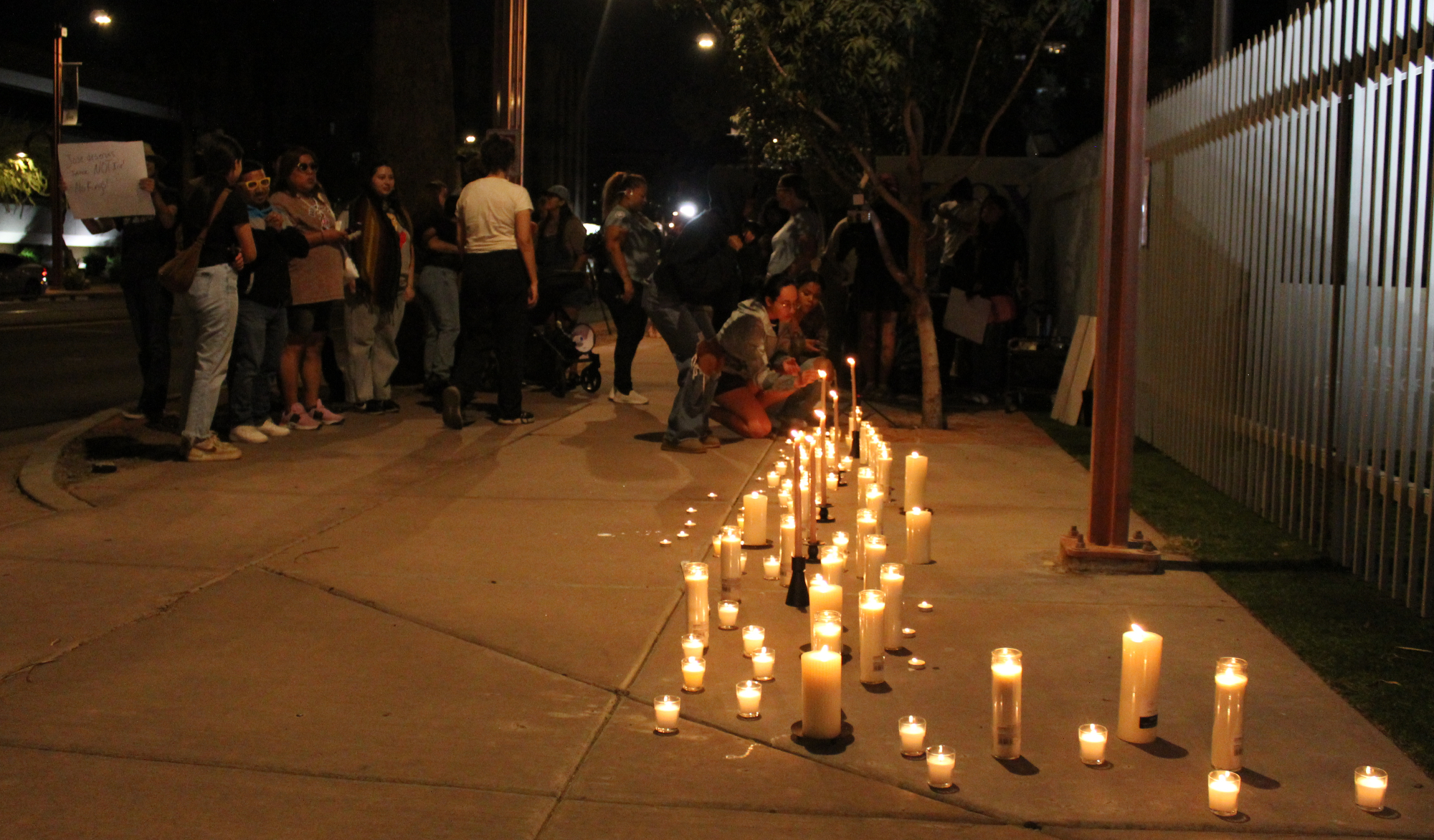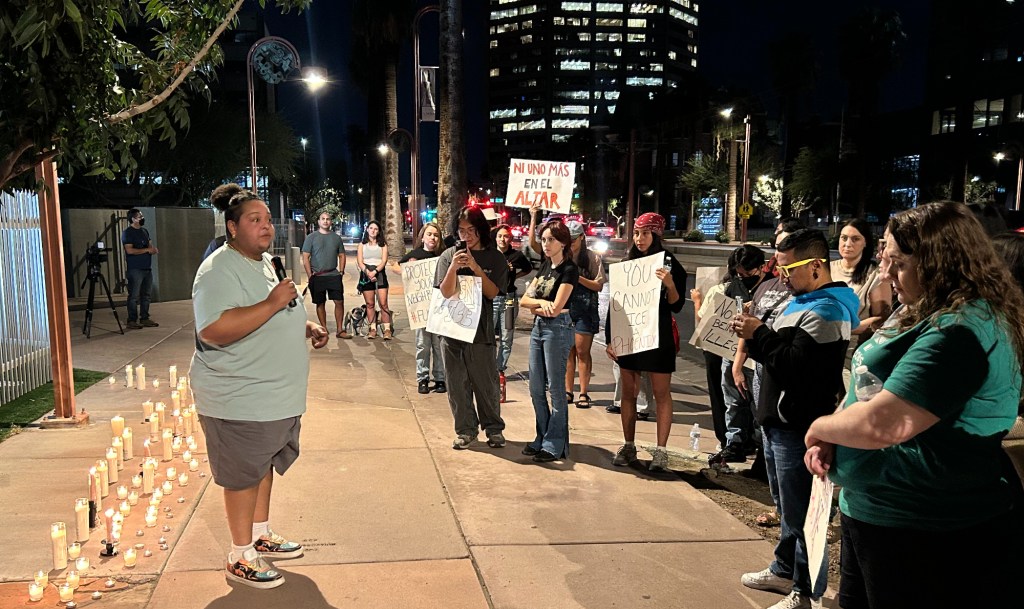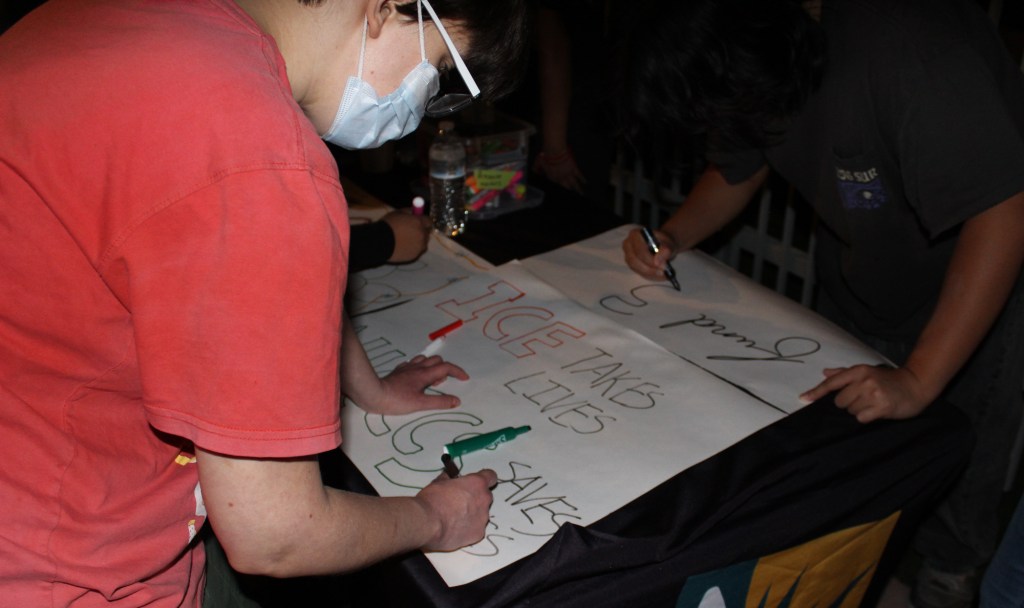
TJ L’Heureux

Audio By Carbonatix
About 14 hours after Immigration and Customs Enforcement officials shot at a driver during a traffic stop early Wednesday morning, activists gathered outside the agency’s Phoenix field office on Central Avenue to hold a vigil as cars zoomed down the busy corridor. The driver, identified by ICE as undocumented Honduran immigrant Jose Garcia-Sorto, was injured in the incident, though it’s not clear if he was struck by a bullet.
Between 40 and 50 people — including Phoenix City Councilmember Anna Hernandez and state Sen. Analise Ortiz, both Democrats — gathered outside the ICE office around 6 p.m. Candles dotted the ground as a sequence of speakers made remarks and dozens of others held anti-ICE signs.
The field office, which was likely emptied out for the day, was otherwise quiet.
“We still don’t know the details of why (ICE) stopped this person,” Hernandez told reporters, adding that the agency was operating “without transparency or identification” and harassing the community.
This year, make your gift count –
Invest in local news that matters.
Our work is funded by readers like you who make voluntary gifts because they value our work and want to see it continue. Make a contribution today to help us reach our $30,000 goal!
“That is part of the problem — they’re handling this in the shadows,” Hernandez added. “That’s not how things should be. That’s what worries me.”
Federal agents stopped Garcia-Sorto while he was driving on Interstate 17 in north Phoenix around 4 a.m. In a statement to Phoenix New Times, ICE said that Garcia-Sorto initially stopped his car but began to drive away as officers approached. The reason agents stopped him remains unclear. ICE told New Times that the agent who shot Garcia-Sorto “fear(ed) for his life” and “defensively discharged his service weapon two times.”
Garcia-Sorto was taken to a hospital and is reportedly in stable condition, though ICE has not said if he was struck by gunfire or injured in some other manner. Pictures from the scene show that the driver’s side window of Garcia-Sorto’s car was damaged, though it’s not clear if that’s because it was shot. An ICE spokesperson said the agency could not answer if the damage to the car’s window was from a bullet because it remains an active FBI investigation.

TJ L’Heureux
For many community members in politically active circles of Phoenix, the incident is yet another example of federal immigration authorities’ disregard and contempt for the lives of immigrants — and even brown American citizens.
“We are grateful that (Garcia-Sorto) is still alive and pray that he remains alive,” said Maria Teresa Mabry, the co-executive director of the Arizona Democracy Resource Center. “We know that this is not an isolated incident, that police brutality and harm from the state is not new for us. But it is more important in this moment that we come together, see each other, build with each other and know that we are the folks who are going to keep us safe.”
Karla Bautista, director of Trans Queer Pueblo’s liberation project for LGBTQ+ undocumented and migrant patients, told the crowd in Spanish that the federal authorities are “fomenting fear” in an attempt to silence marginalized people.
Bautista told the story of Yari Marquez, a Phoenix resident with leukemia who has been detained at ICE’s Eloy Detention Center since February. Family and friends of Marquez, who has spent twenty years in the United States and has had a green card for two years, say she is dying due to a lack of adequate medical care in the facilities. Rep. Yassamin Ansari, a Phoenix Democrat, said the same thing after visiting Marquez there earlier this year.
“Our migrant, LGBTQ and people of color communities are fed up with suffering from this violence pushed by political motives,” Bautista said. “ICE is one of the deadliest government agencies. The Eloy Detention Center is one of the deadliest in the nation. There, our detained brothers and sisters are living in unsanitary conditions with access to health care. They are killing us.”

TJ L’Heureux
Joel Cornejo, a grassroots organizer with Semillas Arizona, did not mince words in denouncing the agency.
“ICE is not public safety. ICE is violence. ICE is trauma. ICE is terror dressed as law,” Cornejo said. “We are here tonight because we refuse to let fear speak louder than justice. We are here because we know the only protection we can truly count on is each other.”
Clarissa Vela — founder of the People First Project, which aims to teach people about their rights in ICE interactions — explained various ways that citizens can assist their community members in danger.
“One of the things you can do is pull over and film. If you’re there, you’re holding them accountable,” Vela said. “We’re watching every day as people are being taken.”
Vela also encouraged people to reject ICE agents’ requests to enter homes if they don’t have authorization, using language like, “I don’t have to open the door. Where’s your warrant? Come back with a warrant.”
Her organization also responds to ICE sightings and tries to assist community members being targeted by responding to ICE sightings reported to a hotline at (888) 354-4594.
“We’ll get there before the police,” she said. “Our average response time is eight to 12 minutes,” adding that it could get lower with more help.